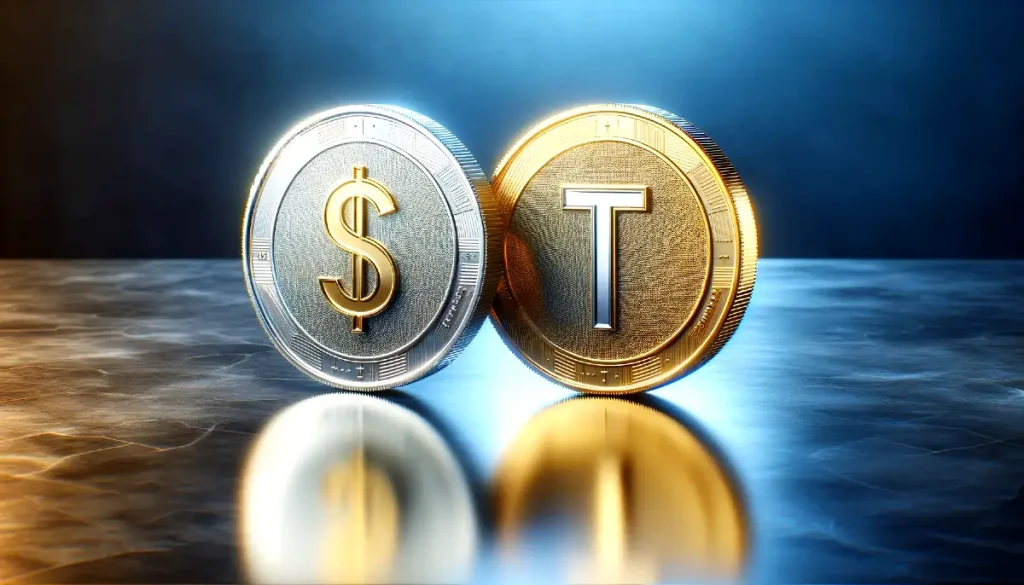USDC vs USDT: Understanding the Difference Between USDC and USDT
Why Stablecoins Like USDT and USDC Matter
Stablecoins have become an integral part of the cryptocurrency ecosystem, acting as a bridge between the volatility of crypto and the stability of fiat currencies. As stablecoins gain popularity, two options have emerged as major players: USDT and USDC. But what exactly sets these stablecoins apart? This guide will compare the key differences between USDT and USDC to help you determine which stablecoin is better suited for your needs.
What is Tether (USDT)? A Closer Look at the Leading Stablecoin
USDT, or Tether, was one of the first stablecoins on the market. It launched in 2014 and is issued by Tether Limited. USDT aims to peg its value to the US dollar. For every unit of USDT in circulation, Tether claims to have $1 in reserves to back the value. USDT runs on multiple blockchains, including Bitcoin, Ethereum, Tron and others. It has become a popular medium for traders to quickly move funds between exchanges and steer clear of the volatility typical of cryptocurrencies.
USDT dominated the stablecoin market for years. However, it has faced questions over the makeup of its dollar reserves and whether it truly maintains a 1:1 peg. While Tether has looked to improve transparency through third-party attestations, some concerns linger. Nevertheless, USDT remains highly popular due to its first-mover advantage and high liquidity. It ranks as the third largest cryptocurrency by market capitalization.
Introducing USD Coin (USDC): A Regulated Stablecoin Alternative
USDC emerged onto the scene in 2018, launched jointly by Circle and Coinbase. It aimed to address some of the transparency and regulatory concerns surrounding USDT. USDC is regulated as a licensed money transmitter and its dollar reserves are maintained in accounts at US-regulated financial institutions. Grant Thornton LLP conducts monthly attestations to ensure USDC is fully backed by reserved assets.
Being regulated gives USDC greater transparency compared to Tether. All USDC transactions and holdings can be viewed via public block explorers and independent audits verify its reserves. Further, USDC complies with anti-money laundering and identity verification regulations to prevent financial crimes. USDC has quickly gained ground on USDT and generally maintains its $1 peg. It runs on numerous blockchains, offering flexible transfer options and robust smart contract integration.
Comparing the Stability Mechanisms of USDT vs USDC
When it comes to stability, both USDT and USDC aim to maintain parity with the US dollar. Their pegs have held up relatively well over time, with only occasional slight deviations. USDT’s market cap exceeds USDC’s by a large margin, though USDC has steadily eaten into Tether’s lead. The greater network effects and liquidity of USDT make it less susceptible to large price swings and loss of peg. Still, for those prioritizing transparency and regulatory oversight, USDC represents the more trusted choice.
USDT and USDC Reserves: The Importance of Transparency
Perhaps the most crucial difference between USDT and USDC comes down to the transparency of reserves. USDT has faced allegations that its stablecoin is not fully backed 1:1 with fiat reserves. While Tether points to third-party attestations, many have called for official audits of its reserves. This opacity leads some to question whether USDT is vulnerable to bank runs during crypto downturns.
In contrast, USDC provides high transparency through monthly attestations and public explorer tools. Anyone can verify USDC’s USD reserves at any time. Further, USDC holds reserves at regulated US banks, reducing counterparty risks. For those who value perfect oversight of backing assets, USDC is likely the preferable stablecoin.
How USDT and USDC Approach Compliance and Security Differently
USDC adheres to stringent US federal regulations surrounding money transmission. Its parent company, Circle, is registered as a money services business with FinCEN. USDC reserves are held at banks insured by the FDIC. This regulatory compliance gives greater protections compared to USDT. However, USDC’s integration with the traditional financial system also carries some risks. Account freezes or seizures are more likely with regulated entities compared to decentralized options like USDT.
Both USDT and USDC utilize technical measures like cryptographic key storage and audits to provide security. USDT benefits from its decentralized model. USDC balances security with compliance using a more centralized hybrid approach. Those who value regulatory protections may prefer USDC, while others may favor Tether’s decentralized security model.
USDT vs USDC: Assessing Market Dominance and Liquidity
In the cryptocurrency markets, liquidity is king. USDT has a massive lead over USDC when it comes to trading volume and overall market pairs. Tether is accepted at virtually every exchange and DeFi platform. It offers seamless transfers between assets. USDT’s first-mover advantage makes it hard for USDC to fully catch up in liquidity metrics.
That said, USDC has quickly gained ground as it gets integrated across the crypto ecosystem. Its liquidity improves each month. For those needing to move large amounts of value, USDT still holds the advantage. But for retail transfers, USDC now offers sufficient liquidity on par with Tether. As USDC expands, expect its liquidity gap with USDT to keep tightening.
Transaction Speed and Fees: Understanding USDT and USDC Networks
Both USDT and USDC offer fast transaction times of just a few seconds on native blockchains like Ethereum. Fees vary based on network activity but typically average under $1. USDT’s wider network integration allows cheaper fees compared to USDC. But for basic transfers, fees are negligible for both.
Users should keep in mind that USDT and USDC transfers between exchanges via external wallets will require on-chain transactions. This incurs mining fees that can get expensive during times of high network usage. For cheap transfers between exchanges, keeping funds within exchange wallets may make more sense.
Real World Use Cases and Adoption Scenarios for Each Stablecoin
As the longest-running stablecoin, USDT is accepted broadly across the entire crypto ecosystem. It is used extensively for trading, arbitrage, moving funds, and settlements. USDT is a critical part of global crypto commerce. It also sees significant use in overseas remittances where consumers want to avoid high fees and volatility.
While not as widely used, USDC sees high utility for crypto-to-fiat on-ramps and off-ramps. Many regulated exchanges utilize USDC for fiat gateways given its compliant nature. USDC also sees adoption for commerce, gaming, and decentralized finance (DeFi) applications where stability is beneficial. Expect use cases for both stablecoins to keep expanding over time.
Potential Risk Factors When Using Either USDT or USDC
While stablecoins carry less volatility compared to other cryptocurrencies, they are not without risks. For USDT, its opacity around reserve holdings sparks concerns about the potential loss of the peg and bank runs. However, USDT’s decentralized nature means funds cannot be frozen or seized easily. Holders of USDC face risks around account freezes and blacklisting enforced by regulated custodians. No stablecoin is entirely immune from peg instability during market turmoil.
Comparative Overview of USDT vs. USDC: Key Features and Differences
| Feature | USDT | USDC |
|---|---|---|
| Backing and Reserves | Claims of $1 in reserves for each USDT. | Fully backed by reserved assets, monthly attestations. |
| Regulatory Compliance | Faces scrutiny, improved transparency. | Regulated, transparent, complies with anti-money laundering regulations. |
| Market Presence | Largest market cap, high liquidity. | Rapidly growing, strong adoption. |
| Transaction Fees & Speed | Varies by blockchain, generally low. | Comparable to USDT, depends on network. |
| Use Cases and Adoption | Broad use across trading, remittances. | Increasingly used for on/off ramps, DeFi. |
| Smart Contract Integration | Widely used in DeFi platforms for its flexibility. | Strong integration with DeFi protocols, favored for regulated operations. |
| Cross-Chain Availability | Available on multiple blockchains, enhancing interoperability. | Supported on several major blockchains, with ongoing expansion. |
| Interest Earning Options | Various platforms offer interest on USDT holdings. | Interest options available, often seen in regulated DeFi projects. |
| Security Features | Utilizes standard security protocols across blockchains. | Adheres to stringent security measures, with regular audits and compliance checks. |
Looking Ahead: Future Developments and Trends in Stablecoins
As for recent developments and future outlooks, it’s essential to note the increasing regulatory scrutiny on stablecoins, with both USDT and USDC enhancing transparency and compliance efforts. The evolving regulatory landscape and potential for broader adoption in digital payments and DeFi are key areas to watch, suggesting a promising yet cautious future for stablecoins in mainstream finance. For the most current updates, checking the latest news on reputable cryptocurrency news websites is recommended.
Choosing Between USDT and USDC: Key Factors to Consider
When deciding between using USDT vs USDC, the key considerations come down to transparency, compliance, liquidity needs, and risk tolerance. For those wanting a fully regulated and transparent option, USDC is likely the best fit. Traders dependent on deep liquidity may still prefer USDT. DeFi users or businesses aiming to avoid oversight may favor Tether’s decentralized attributes. While their standards differ, both USDT and USDC offer relative stability amidst crypto volatility. As the stablecoin market matures, expect both options to continue playing important yet distinct roles for years to come.








